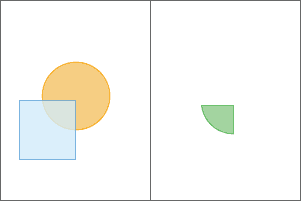
ST_Intersection takes two geometry columns and returns a geometry column. The output column contains the
intersection of two input geometry records. You can optionally specify a string value that determines the geometry type of the
result. The string can be one of: 'point', 'multipoint', 'linestring', or 'polygon'. If no intersection type is specified,
the function will return the same geometry type as the input geometry with the lowest dimension. For example, if you
calculate the intersection of a polygon and a linestring the function will return a linestring.
The function will return an empty geometry if the two input geometries do not intersect or there is no intersection that matches the specified intersect type. If the intersection is a single point, the geometry type of the result column will be a multipoint.
To find the intersection of all records in a column or a group use ST_Aggr_Intersection.
| Function | Syntax |
|---|---|
| Python | intersection(geometry1, geometry2, intersect |
| SQL | ST |
| Scala | intersection(geometry1, geometry2, intersect |
For more details, go to the GeoAnalytics Engine API reference for intersection.
This function implements the OpenGIS Simple Features Implementation Specification for SQL 1.2.1.
Examples
from geoanalytics.sql import functions as ST, Linestring, Polygon
data = [
(Polygon([[[0,0],[10,10],[20,0]]]), Linestring([[[5,2],[20,20]]])),
(Polygon([[[0,0],[10,10],[20,0]]]), Linestring([[[30,40],[32,43]]])),
]
df = spark.createDataFrame(data, ["polygon", "linestring"])
df.select(ST.intersection("polygon", "linestring").alias("intersection")).show(truncate=False)+---------------------------------------------------------+
|intersection |
+---------------------------------------------------------+
|{"paths":[[[5,2],[10.90909090909091,9.090909090909092]]]}|
|{"paths":[]} |
+---------------------------------------------------------+Version table
| Release | Notes |
|---|---|
1.0.0 | Python and SQL functions introduced |
1.5.0 | Scala function introduced |